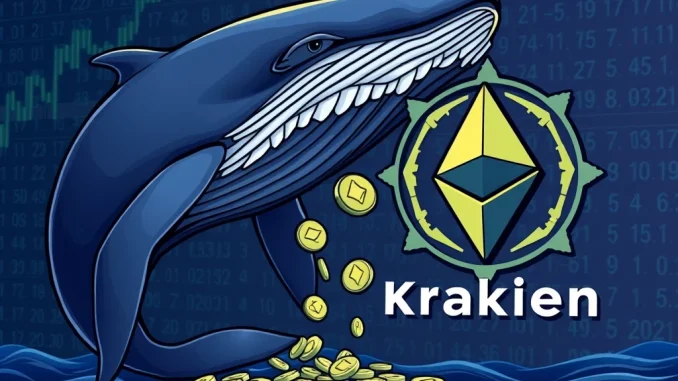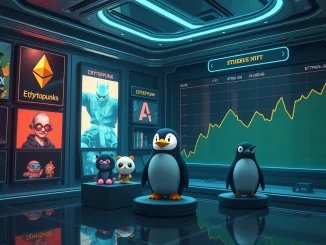
The world of cryptocurrency often sees significant movements from early participants, and a recent transaction has caught the attention of the crypto market. An individual identified as an Ethereum ICO whale, one who participated in the initial coin offering back in 2015, has made a substantial ETH deposit into the Kraken exchange.
Who is This Ethereum ICO Whale?
This particular address is linked to an early participant in the Ethereum initial coin offering (ICO) held in 2015. During that historic event, this wallet acquired a staggering 100,000 ETH. At the time, the total cost for this massive holding was a mere $31,000. Fast forward to today, and the value of that initial investment has multiplied exponentially, showcasing the incredible growth of the Ethereum network over the years.
Holding such a large amount of ETH from the very beginning classifies this address as a ‘whale’ in the crypto space. Whales are individuals or entities holding significant amounts of a particular cryptocurrency, and their movements are often tracked closely by analysts and other market participants due to their potential to influence price.
The Significant ETH Deposit to Kraken Exchange
According to on-chain data tracked by platforms like Onchain Lens on X, the Ethereum ICO whale recently moved a substantial portion of their holdings. The transaction involved depositing 2,839 ETH directly into the Kraken exchange. At the time of the deposit, this amount was valued at approximately $7.32 million.
Here are the key details of the deposit:
- **Amount Deposited:** 2,839 ETH
- **Approximate USD Value:** $7.32 million (at the time of deposit)
- **Destination:** Kraken Exchange
- **Origin:** Wallet linked to an Ethereum ICO participant
This isn’t the first time early ETH holders have moved funds, but each significant movement warrants attention, especially when directed towards a centralized exchange like Kraken.
Why Does a Large ETH Deposit Matter?
Depositing a large amount of cryptocurrency onto an exchange is often interpreted by the market as a precursor to selling activity. When large holders, or whales, move funds from cold storage or private wallets onto exchanges, it increases the supply of that asset available for trading on the platform. If the whale decides to sell, this influx of supply could potentially put downward pressure on the Ethereum price.
However, it’s crucial to understand that a deposit does not automatically equal a sale. There are several reasons a whale might deposit funds:
- **Potential Selling:** The most common assumption is that the whale intends to sell some or all of the deposited ETH to realize profits or rebalance their portfolio.
- **Trading or Staking:** They might deposit to engage in active trading strategies, provide liquidity, or participate in staking programs offered by the exchange.
- **Transfer for Other Assets:** The deposit could be in preparation for trading ETH for other cryptocurrencies or even fiat currency.
- **Diversification:** Moving funds might be part of a broader strategy to diversify holdings across different exchanges or asset classes.
Without direct confirmation from the wallet owner, the exact intention behind this specific ETH deposit remains speculative. However, the sheer size of the deposit from such an early and profitable participant naturally leads to discussions about potential selling pressure on the crypto market.
Historical Context of Whale Movements and Ethereum Price
Tracking the movements of large holders is a common practice in cryptocurrency analysis. Historically, significant whale activity has sometimes correlated with price volatility. Large sales can lead to price drops, while large withdrawals from exchanges might indicate accumulation or a move to long-term storage, potentially seen as bullish signs.
The Ethereum ICO whale addresses are particularly interesting because their cost basis is incredibly low ($0.31 per ETH). This means they have immense unrealized gains and significant flexibility in their decisions, whether to sell a small portion, a large chunk, or hold for even longer.
While one whale’s actions, even a significant one, don’t solely dictate the direction of the entire crypto market or the Ethereum price, they are a factor that market participants monitor closely. This deposit to Kraken exchange adds another data point to the ongoing analysis of market dynamics.
What Could This Mean for the Crypto Market and Ethereum Price?
The immediate impact of this specific deposit on the overall crypto market might be limited unless a large-scale sell-off occurs. The $7.32 million deposit, while substantial for an individual, represents a fraction of Ethereum’s daily trading volume and market capitalization.
However, the news contributes to market sentiment. If other whales or large holders see this movement and decide to follow suit, it could create a cascade effect. Conversely, if the market absorbs any potential selling pressure without a significant price drop, it could be interpreted as a sign of strength.
For those tracking the Ethereum price, this deposit serves as a reminder to observe exchange flows and whale movements. It’s a piece of the puzzle in understanding potential supply dynamics. Traders and investors often look at exchange balances and large transactions to gauge potential shifts in selling or buying pressure.
Conclusion: Monitoring Whale Activity on Kraken Exchange
The recent ETH deposit of $7.32 million by an Ethereum ICO whale into the Kraken exchange is a notable event in the crypto space. While the ultimate intention behind the deposit remains unknown, it highlights the potential for large, early holders to influence market dynamics. This movement serves as a key data point for analysts and participants monitoring the Ethereum price and the broader crypto market.
Whether this leads to a significant sale or is part of another strategy, tracking the behavior of such large wallets provides valuable insights into the potential supply side of the market. As always, market participants should consider various factors, not just individual whale movements, when making decisions.



